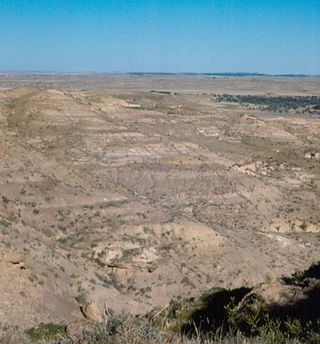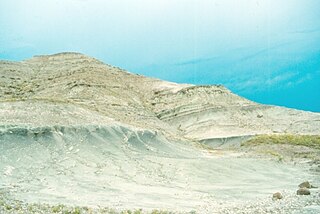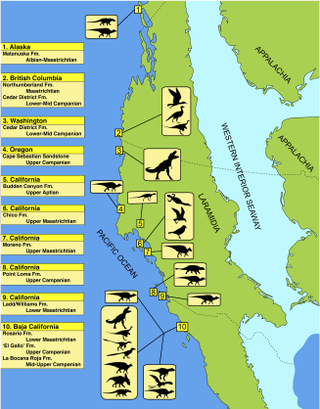
Trachodon is a dubious genus of hadrosaurid dinosaur based on teeth from the Campanian-age Upper Cretaceous Judith River Formation of Montana, U.S. It is a historically important genus with a convoluted taxonomy that has been all but abandoned by modern dinosaur paleontologists.

Olorotitan was a monotypic genus of lambeosaurine duck-billed dinosaur, containing a single species, Olorotitan arharensis. It was among the last surviving non-avian dinosaurs to go extinct during the Cretaceous–Paleogene extinction event, having lived from the middle to late Maastrichtian-age of the Late Cretaceous era. The remains were found in the Udurchukan Formation beds of Kundur, Arkharinsky District, Amur Oblast, Eastern Russia, in the vicinity of the Amur River.

The Lance (Creek) Formation is a division of Late Cretaceous rocks in the western United States. Named after Lance Creek, Wyoming, the microvertebrate fossils and dinosaurs represent important components of the latest Mesozoic vertebrate faunas. The Lance Formation is Late Maastrichtian in age, and shares much fauna with the Hell Creek Formation of Montana and North Dakota, the Frenchman Formation of southwest Saskatchewan, and the lower part of the Scollard Formation of Alberta.

Lophorhothon is a genus of hadrosauroid dinosaur from the Late Cretaceous of Alabama and North Carolina. It was the first genus of dinosaur discovered in Alabama, in the United States.

Aletopelta is a monospecific genus of basal ankylosaurid dinosaur from Southern California that lived during the Late Cretaceous in what is now the Point Loma Formation. The type and only species, Aletopelta coombsi, is known from a partial skeleton preserving osteoderms. It was originally described in 1996 by W. P. Coombs, Jr. and T.A. Deméré before being named in 2001 by Tracy Ford and James Kirkland. Aletopelta has an estimated size of 5 metres and weight of 2 tonnes. The holotype formed a miniature reef and was scavenged upon by invertebrates and sharks.

The Two Medicine Formation is a geological formation, or rock body, in northwestern Montana and southern Alberta that was deposited between 83.5 ± 0.7 Ma and 70.6 ± 3.4 Ma, during Campanian time. It crops out to the east of the Rocky Mountain Overthrust Belt, and the western portion of this formation is folded and faulted while the eastern part, which thins out into the Sweetgrass Arch, is mostly undeformed plains. Below the formation are the nearshore deposits of the Virgelle Sandstone, and above it is the marine Bearpaw Shale. Throughout the Campanian, the Two Medicine Formation was deposited between the western shoreline of the Late Cretaceous Interior Seaway and the eastward advancing margin of the Cordilleran Overthrust Belt. The Two Medicine Formation is mostly sandstone, deposited by rivers and deltas.
Microhadrosaurus is a genus of hadrosaurid dinosaur from the Campanian or Maastrichtian-age Upper Cretaceous Yuanpu Formation of Guangdong, China. Although its name identifies it as a small hadrosaur, it is based on juvenile remains, and the size of the adult hadrosaur is unknown.
The Cedar Mountain Formation is the name given to a distinctive sedimentary geologic formation in eastern Utah, spanning most of the early and mid-Cretaceous. The formation was named for Cedar Mountain in northern Emery County, Utah, where William Lee Stokes first studied the exposures in 1944.

The Wayan Formation is a geological formation in Idaho whose strata date back to the latest Early Cretaceous and the earliest Late Cretaceous. Dinosaur, other reptile, mammal, and micro and macro-floral remains are among the fossils that have been recovered from the formation. The lack of extensive outcrops, limited geographic extent, and extreme structural deformation have limited paleontological explorations of the Wayan.
The Matanuska Formation consists of more than 3 km (1.9 mi) of sedimentary strata exposed in the northern Chugach Mountains, Matanuska Valley, and southern Talkeetna Mountains of south-central Alaska. The Matanuska Formation contains strata from Early Cretaceous (Albian) to Late Cretaceous (Maestrichtian). Parts of the formation contain abundant marine mollusks, foraminifera, and radiolaria. Fossils of nonmarine plants are found in some beds. Fossils of two dinosaurs have been recovered from marine mudstones in the formation. The lower Matanuska Formation (MF) is several hundred meters thick and includes nonmarine and marine sediments. Campanian-Maastrichtian graded sandstone, conglomerate, and mudstone comprise the upper 2000 m of the Formation.

The El Gallo Formation is a geological formation in Mexico whose strata date back to the Late Cretaceous, Campanian epoch, specifically dated to 75.21 ± 0.07 Ma and 74.55 ± 0.09 Ma. Dinosaur remains are among the fossils that have been recovered from the formation.
La Bocana Roja Formation is a geological formation in Baja California, Mexico whose strata date back to the Late Cretaceous. Dinosaur remains are among the fossils that have been recovered from the formation.

The Cape Sebastian Sandstone is a Mesozoic geologic formation in the state of Oregon in the United States. Hadrosaurid dinosaur remains, such as the sacrum of the Cape Sebastian ornithopod, are among the fossils that have been recovered from the formation, although none have yet been referred to a specific genus. The formation dates to the Campanian stage of the Late Cretaceous epoch.
The Chico Formation is a geologic formation of the Campanian Age during the Cretaceous Period, found in California and southern Oregon.
The Ladd Formation is a Mesozoic geologic formation located in Orange County, California.
The Lomas Coloradas Formation is a Mesozoic geologic formation in Mexico. Dinosaur remains are among the fossils that have been recovered from the formation, although only a few have yet been referred to a specific genus. Indetermiate hadrosaur remains and indeterminate sauropod remains, most likely belonging to Alamosaurus, have been unearthed here.
The Williams Formation is a Mesozoic geologic formation. Dinosaur remains are among the fossils that have been recovered from the formation, although none have yet been referred to a specific genus. In 1996 Gino Calvano found foot bones, two cervical vertebrae, and a phalanx (toe) from a hadrosaur in this formation, along the western base of the Santa Ana Mountains in Orange County, California.
The Cabrillo Formation is a Maastrichtian stage geologic formation in coastal San Diego County, southern California. It is part of the Rosario Group. The Maastrichtian stage is of the Late Cretaceous Epoch, during the Mesozoic Era.
The La Jolla Group is a group of geologic formations in coastal southwestern San Diego County, Southern California. Its locations include the coastal La Jolla San Diego region.
The Rosario Group is a Late Cretaceous geologic group in southwestern California and northwestern Baja California (Mexico). In older literature it was named Rosario Formation.










